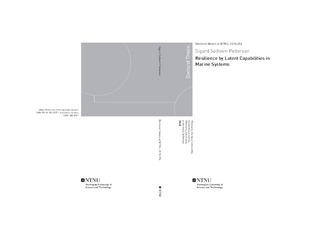| dc.contributor.advisor | Asbjørnslett, Bjørn Egil | |
| dc.contributor.advisor | Fagerholt, Kjetil | |
| dc.contributor.author | Pettersen, Sigurd Solheim | |
| dc.date.accessioned | 2019-01-24T14:02:09Z | |
| dc.date.available | 2019-01-24T14:02:09Z | |
| dc.date.issued | 2018 | |
| dc.identifier.isbn | 978-82-326-3577-1 | |
| dc.identifier.issn | 1503-8181 | |
| dc.identifier.uri | http://hdl.handle.net/11250/2582216 | |
| dc.description.abstract | This thesis addresses the need for resilience, the ability of a system to recover from a disruption, in marine systems. It proposes to enhance resilience in the operational phase by taking advantage of latent capabilities, those capabilities that exist without neither being intended nor recognized during the design process. Marine systems like offshore support vessels are often complex, multi-functional assets, operating in a highly volatile environment. For these vessels to deliver value throughout an uncertain lifecycle, there is a need for addressing disruptions that occur during operations, and for enabling vessels to support emergency response. The topic of the thesis is motivated by the fact that not all negative events can be avoided, meaning something unforeseen will happen, and the fact that exposure to some uncertainty can be beneficial, implying opportunity rather than risk.
The research question addressed in this thesis concerns the relationship between the design characteristics of marine systems, and the ability of marine systems to recover from events that disrupt their operation or to respond to emergencies in the maritime environment. Providing additional structure to the problem situation, a set of five research objectives were formulated. These objectives are systematically met through four main articles, which document the analyses and results. Main Article 1 documents the ill-structured problem in early-stage ship design, starting from application of systems engineering methods for managing future uncertainty in design of offshore support vessels. Main Article 2 introduces the latent capabilities concept and connects it to resilience by using a function-form mapping model. Building on the case of Apollo 13, the article concludes in opposition to axiomatic design, seeing functional dependence as an enabler of resilience. Main Article 3 applies latent capabilities as an enabler of emergency response provided by advanced offshore support vessels. It uses the Deepwater Horizon case to argue for latent capabilities in the offshore industry and discusses key advantages and challenges to exploiting latent capabilities. Main Article 4 extends latent capabilities to the fleet level using fleet deployment to measure effectiveness, beyond what can be captured in ship design analyses.
The outcome of the research is an improved understanding of the relationship between design characteristics and the ability of marine systems to recover or to be recovered after unforeseen events. This is documented through five contributions: First, an industrial case study produced insights to design of advanced offshore vessels. Second, a conceptual framework for latent capabilities was developed. Third, models that relate latent capabilities to resilience were outlined. Fourth, a methodology was developed for assessment of latent capabilities in contingency planning, drawing on the modelling insights and a review of mission reports. Fifth, a deployment model captures the emergence of latent capabilities on the fleet level by measuring effectiveness beyond what is obtainable through single ship performance measures.
In conclusion, the research question is answered by adding to the overall knowledge about the relationship between latent capabilities and system resilience. Latent capabilities can contribute to enhanced resilience by enabling exploitation of functionality a system was not originally intended for. Hence, once new needs emerge, resources exist that can be used to resolve them. This requires that challenges for utilization of latent capabilities, including technical, operational, commercial and organizational factors, can be identified. While such factors have been identified in this work, further quantification of their relative importance is needed, before a methodology for assessment of latent capabilities is mature. | nb_NO |
| dc.language.iso | eng | nb_NO |
| dc.publisher | NTNU | nb_NO |
| dc.relation.ispartofseries | Doctoral theses at NTNU;2018:394 | |
| dc.relation.haspart | Paper 1: Pettersen, Sigurd Solheim; Rehn, Carl Fredrik; Garcia Agis, Jose Jorge; Erikstad, Stein Ove; Brett, Per Olaf; Asbjørnslett, Bjørn Egil; Ross, Adam M.; Rhodes, Donna. Ill-Structured Commercial Ship Design Problems: The Responsive System Comparison Method on an Offshore Vessel Case. Journal of Ship Production and Design 2018 ;Volum 34.(1) s. 72-83
https://doi.org/10.5957/JSPD.170012 | nb_NO |
| dc.relation.haspart | Paper 2: Pettersen, Sigurd Solheim; Erikstad, Stein Ove; Asbjørnslett, Bjørn Egil. Exploiting latent functional capabilities for resilience in design of engineering systems. Research in Engineering Design 2018 ;Volum 29.(4) s. 605-619
https://doi.org/10.1007/s00163-017-0279-y | nb_NO |
| dc.relation.haspart | Paper 3: Latent capabilities in support of maritime emergency response | nb_NO |
| dc.relation.haspart | Paper 4: Evaluating fleet effectiveness in tactical emergency response missions using a maximal covering formulation | nb_NO |
| dc.title | Resilience by Latent Capabilities in Marine Systems | nb_NO |
| dc.type | Doctoral thesis | nb_NO |
| dc.subject.nsi | VDP::Technology: 500::Marine technology: 580 | nb_NO |

